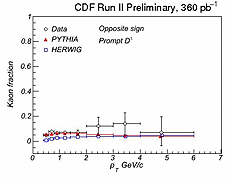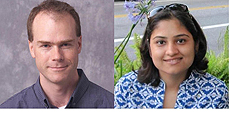Never alone
 |
| The top plot shows the fraction of charged particles produced around a Ds+ meson that are kaons as a function of the particle transverse momentum. The bottom plot shows the fraction produced around a D+ meson.
A larger kaon fraction is observed in association with Ds+ production because the kaon contains the strange quark produced
in association with the antistrange quark found in the Ds+ meson.
The pair of strange quarks is created as the gluon string breaks
at the end closest to the heavy quark. |
When produced in high-energy collisions, quarks are never observed in isolation as free particles. Instead, all quarks remain connected to other fundamental particles produced in a collision by a "string" of gluons.
At low energies, these gluons bind quarks and antiquarks together to
form stable mesons. But at higher energies, the string can break and
reconnect to new quark-antiquark pairs that are created out of the
energy stored in the stretched string.
We can watch this process in action by studying bottom or charm quarks, which are initially produced in proton-antiproton collisions. The bottom and charm quarks can ultimately be found inside a heavy meson, such as a B+ or D+, respectively. But once the quark is bound inside one of these particles, what happens to the rest of its string?
Scientists have tuned models to describe the average properties of the mesons created in the
fragmentation process, but it would be interesting to watch what happens to the end of the string that remains immediately after the part connected to the heavy quark is broken.
Recently, the CDF experiment did exactly this by looking at the properties of kaons produced in association with Ds+ mesons. In this case, when a gluon string breaks, the strange quark in a K- is produced at the same time as the antistrange quark needed to form the Ds+ meson.
Kaons produced in this way were shown to have distinctly different properties when compared to kaons produced in association with D+ mesons, which instead contain an antidown quark, consistent with fragmentation models.
—Matthew Jones
Learn more
 |
| Matthew Jones (Purdue University), left, and Niharika Ranjan Singh (formerly Purdue University, now at Google) are the primary analysts for this result. |
|